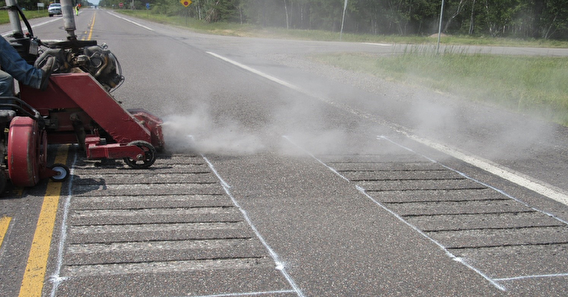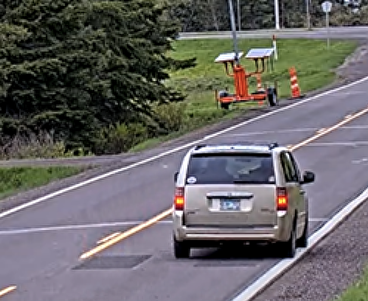
Transverse rumble strips (TRS), which run across a traffic lane, are a low-cost and easily deployable safety countermeasure for intersection approaches. While some studies have shown TRS are effective at slowing speeds and encouraging stopping, there is little consistency in placement or design. Variables include the number of panels (or sets of strips), strips per panel, dimensions of strips, and distances to traffic signs.
To help guide planning, the Minnesota Local Road Research Board funded a study to understand which TRS designs are most effective in changing driver behaviors. Researchers led by Professor Shauna Hallmark of Iowa State University evaluated the effectiveness of different TRS designs on driver speed and stopping behavior at rural stop-controlled intersections.
Eight rural intersections in St. Louis County were used as test sites. Researchers used MnDOT’s standard rumble strip dimensions but varied the numbers of panels and strips: Four designs included either two or three panels, with 6 or 12 strips per panel. The first panels were placed 200 feet before the stop signs in each location.
For roughly a week at each location, equipment recorded vehicle movements before rumble strip installation, one month after installation, and nine months after. Video cameras recorded driver behavior variables; investigators also noted whether drivers maneuvered to avoid rolling over the strips. Sound measurements captured how the number of panels and strips affected in-vehicle and exterior noise.

The researchers concluded that the presence of rumble strips in general provides important safety benefits. Regardless of design, for example, most sites in this study experienced decreases in vehicles traveling 40 to 45 mph or more just before the intersection.
Additionally, most sites saw increases in vehicles coming to a rolling or full stop. All sites also had an increase in the percentage of vehicles that stopped behind the stop bar.
Speed changes from upstream (before the TRS) to downstream (near the intersection), however, did not show much improvement. This may be because drivers began slowing sooner upstream once they became aware the rumble strips were in place, say the researchers.
Some drivers move to the left or right to avoid the rumble strips. This is not necessarily a safety issue, the researchers say, since it indicates that drivers are aware of the rumble strips, and the act of shifting left or right may have some speed management benefit. However, placement of wheel path rumble strips should account for drivers shifting from those paths.
Given the low number of sites tested, investigators used a qualitative point system to compare TRS designs. The 3-panel, 12-strip-per-panel design installed at three sites performed the best on most metrics, followed by the 3-panel, 6-strip-per-panel design installed at one site. Researchers recommend a consistent TRS design across a jurisdiction.
The noise evaluations found no significant differences in interior and exterior sound between the 6- and 12-rumble strip designs. Inside a vehicle, both designs provided sound above the level needed to alert a drowsy or distracted driver.
“Though the project didn’t clearly identify a superior transverse rumble strip design, we are comfortable that we have a better idea of design characteristics that are generally effective in encouraging drivers to stop at intersections,” says Victor Lund, traffic engineer with St. Louis County Public Works and the project technical liaison.
Learn more:
- Transverse Rumble Strips at Rural Intersections (LRRB/MnDOT, Apr. 2023)